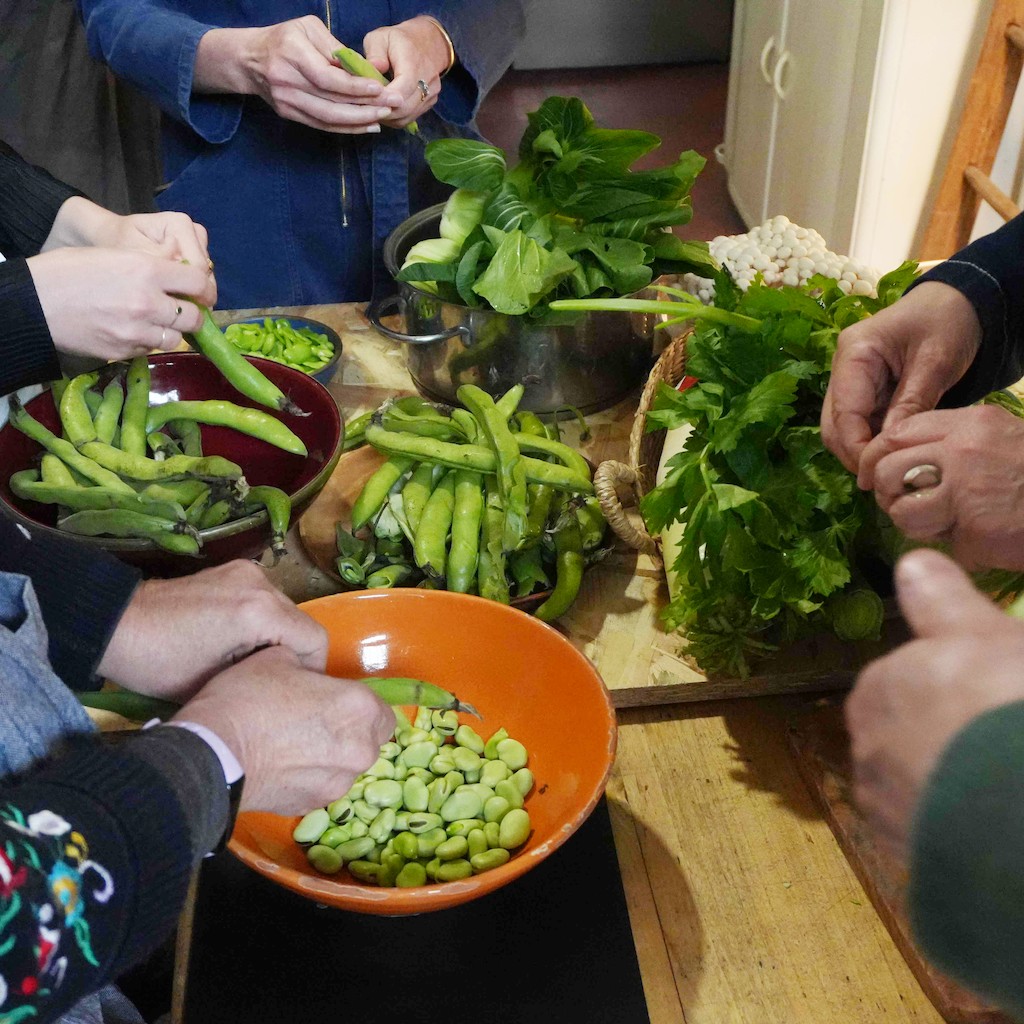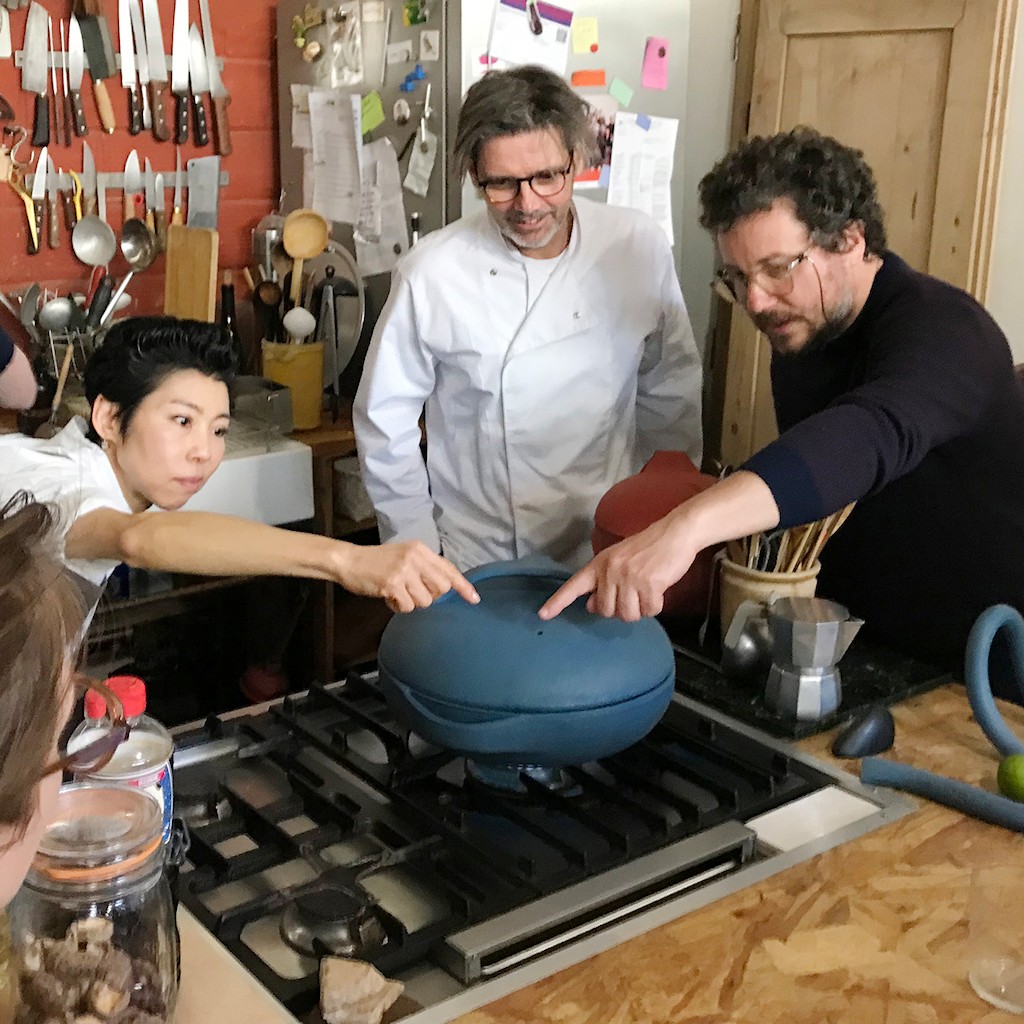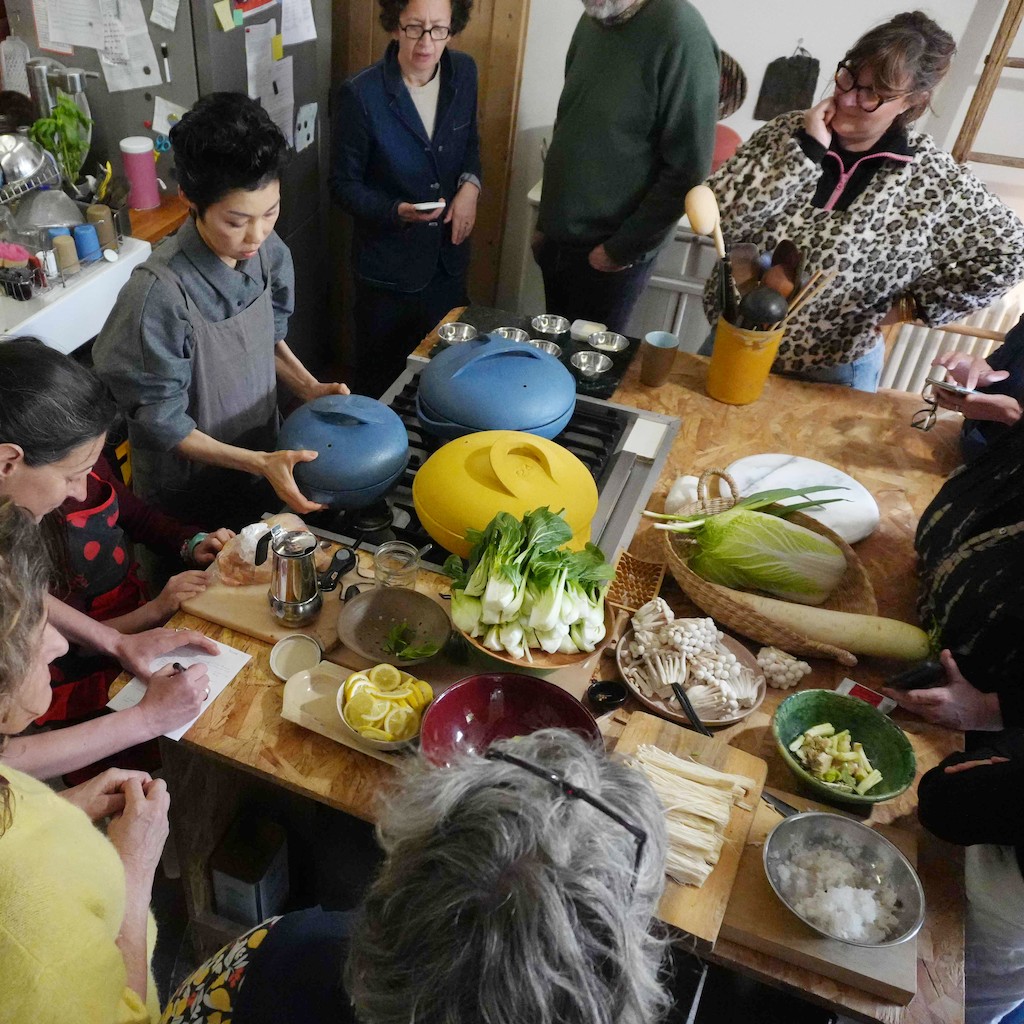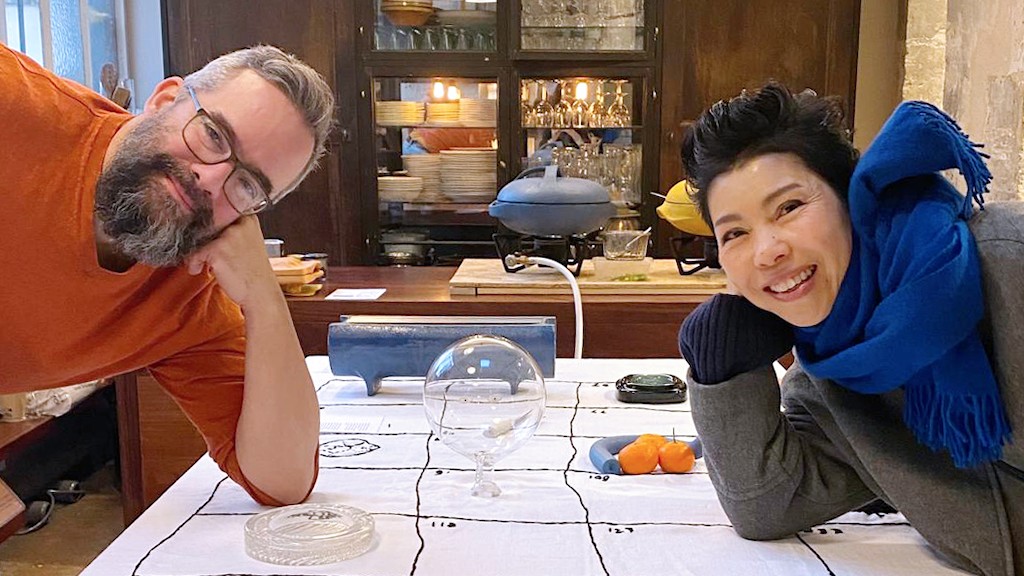
Potter Ben Lignel and chef Shiho Miyamoto at SeptElzévir gallery (Paris). In December 2024, Shiho hosted a workshop at the gallery, demonstrating the use of Ben’s donabe with seasonal winter food. Photo: Leila Naaman.
Ben Lignel shares the insights gained in his new practice as a specialist potter.
In my last article, The ancestral is in vogue: How do you market authenticity?, I discussed the contradiction in which a timeless value comes into fashion. Left unanswered was the question of how we can tell an authentic story without self-consciously seeking to follow a trend.
I found one answer in a recent book by Krzysztof Pelc, Beyond Self-Interest: Why the Market Rewards Those Who Reject It. Pelc analyses this paradox in a variety of manifestations, such as the corporate leader who is “passionate” about their work, the appeal of products “made with love” and the value added by the artist Banksy when he shredded his painting after its auction. It appears that you have a better chance of success if you do not seek it directly.
To better understand how this works, it’s helpful to look at how someone has successfully navigated this paradox. Ben Lignel is a true thinker-maker. He has combined a successful practice as a writer and teacher with an active engagement in making. Lignel has played a key role in contemporary jewellery, not only as a producer of conceptual adornment but also as editor of Art Jewelry Forum.
Recently, he has turned to ceramics, particularly the production of the Japanese donabe, a ceramic pot for slow cooking. Ben works from his home just outside Paris in a tiny workshop that allows him to produce around 100-150 pieces per year. The way he has developed a community around his product is a useful example of how a career can be sustained indirectly by focusing on shared experience rather than individual gain.
Ben’s story is manually generated from our conversation over Google Meet.
✿
Here are the seven steps to authenticity:
Step one: Find the spark
At the time, my children were six and eight. I asked their teacher whether she’d do a parent-child class. I wasn’t so interested in clay, but I did want to do some activities with the kids. She agreed to that, bless her, and that got me hooked. Around the same time, I saw a book in the US written by Japanese-American cook Naoko Takei, focusing on Japanese donabe, or clay hotpots. The shape really was intriguing enough for me to decide to throw myself into ceramics: my initial goal was to try to both reproduce that pot and learn the cooking technique that goes with it.
Because I already had 20 years of experience in craft when I handled clay for the first time, I could see the potential of the material and understood that I could rise to the challenge of becoming a potter. It took perhaps a year from the moment that I took this first class to the moment when I thought: okay, I’m going to rearrange my professional engagements to allow me to develop this and to transition from my teaching practice to a potter’s practice.
Step two: Develop the use case
- Participants shucking beans for a Takikomigohan [boiled rice] with shrimps, beans, and lotus shoots. This dish was cooked during a workshop led by Shiho Moyamoto, using one of Ben’s 5-liters donabe. Montreuil, April 2025
It has been useful to associate showing my pots with the actual production and serving of food from the get-go. I quickly realised that I was going to have to do that, especially in a French market. First, because French cooking has a long tradition, which guides the techniques and utensils that people will feel familiar with. Second, although Japanese cooking is enjoying a lot of public attention here, donabe are relatively unknown. Some education was going to be necessary so that people would understand what these pots can do, how they overlap with their existing cooking practices and what new possibilities they open up.
The surge of interest in Japanese culture has served me well. I’ve been particularly glad to partner with some Japanese chefs: their adoption of my French-made donabe brings a lot of legitimacy to what I’m doing. I am not Japanese, and so when I say that I find these to be great pots, it carries less weight than if a Japanese chef says the same.
Step three: Create a following by sharing knowledge
- Chef Shiho Miyamoto pointing to the steam vent in one of Ben’s donabe during a workshop held in Montreuil, April 2025.
This year, I started hosting cooking classes with chef Shiho Miyamoto, in which she demonstrates how one cooks with donabe. I’ve been trying not to turn these classes into selling exercises. I want to respect the fact that when people sign up for a cooking class, they’re not signing up for someone selling them something else (In fact, the people who sign up for the classes have usually already bought a pot from me).
In the last cooking class that I hosted, there were, by chance, four women who are professionals in the cooking world: chefs, journalists and current or past restaurant-owners. And they were extremely happy to find themselves in this space. That made me understand that these classes are probably less about transaction and learning than connection and community-building. I think I might build on that and propose a spin-off in the form of seminars.
Step four: Meet the needs of others
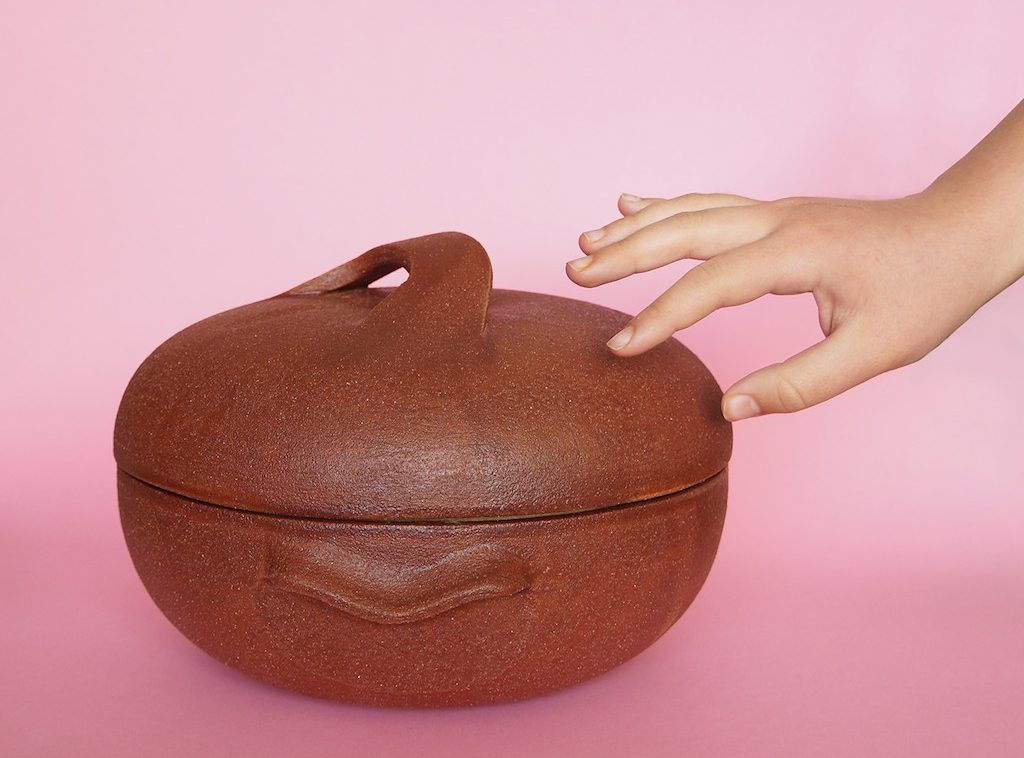
Ben Lignel, Riva, 2025, lidded flameware donabe for 3-4 people, Volume: 2.25 liters, Stoneware, groggy burgundy slip and pale pink glaze (inside)
I was trained as a designer, and I’ve always been resistant to the adulation of the handmade as a justification for buying something. I’m more interested in speaking about the specific possibilities that making things by hand, and one by one, actually opens. I can produce a piece that satisfies the needs of a chef. For example, they may want something of a very particular size, with a precise heat performance. Doing a one-off, by hand, makes complete sense in that case because an industrially set-up company cannot do that. It would cost them too much to produce something as a one-off new design.
People who come here often tell me what they want to hear from me, which is that my pots are made by hand and are unique. Though this is factually true, I’m not the one who’s pushing that: celebrating the handmade, if one does not name the properties or quality that the “handmade” generates, seems a little manipulative or misguided. It’s a storytelling exercise. Just saying that I make things by hand means that they’re imperfectly made.
Nor do I think that the fact that I make them adds to their qualities. Sure, I could not design them if I did not know the clay at fingertip level, and its limits or possibilities. But I would be happy for someone else with adequate skills to not just make them, but improve on them. That could happen as well.
Step five: Be unique

Ben Lignel, Very Large Pot, 2025, Extra-large low flameware cauldron for 20 people, Volume: 10 liters, Stoneware, groggy brown slip and yellow glaze (inside); copper handles
Donabe pots are still a rarity in France, and the more I develop, the more I try to produce things that have no equivalent in the industrial market. The sort of cooking in the pots that I design tend to have collective uses—think “stews” and “hot pots”—that are connected to simple, additive cooking techniques The simple gesture of just throwing vegetables in a pot of water and then adding proteins to it at the end—as was once practice in the French countryside and as continues to be done in Japan. In both contexts, it is something that is really familial and collective.
Step six: Acknowledge others
I like to tell stories, and Instagram has been a great place for me to write about what I do and to think about what I do. The posts that excite me most are those where I find the space to connect what I do to the history of cookware or culinary history. Meanwhile, I’m very hesitant to produce posts just to produce posts: If I have nothing to say, then I’m not going to say it.
Social media has been a good way for me to honour the people that I work with. I’ve been trying to be good about not just mentioning people, but also celebrating their practices. This reflects the way that I move in the world: first, because my practice could not exist were it not for a number of friends and colleagues who participate in it, in whatever way. Second, because cooking is fundamentally collective. So naming the “many hands and many minds” that I am in conversation with every day feels very coherent with the core of what eating, cooking and serving people is about.
 I would name Edith Heath as a “model.” She established her ceramic company on the West Coast just after the Second World War. It went on to become a very successful midsize tableware and tile manufacturer. They struck a very nice balance between research and development, on the one hand, and serialised or partly serialised production, on the other. And their lines were gorgeous.
I would name Edith Heath as a “model.” She established her ceramic company on the West Coast just after the Second World War. It went on to become a very successful midsize tableware and tile manufacturer. They struck a very nice balance between research and development, on the one hand, and serialised or partly serialised production, on the other. And their lines were gorgeous.
Step seven: Be open to adventure
More recently, I’ve started to work on specific commissions for chefs, and that’s been super exciting. I’ve been hoping to get to that stage where people come with their own questions or things that they would like to try. Let me share an example, which I love for how accidental it is.
In January, I was taking a weekend with my companion Lucy in Lisbon, and I needed some smoked paprika. We passed by a spice shop, so I entered and bought the paprika. But then the owner said, “There’s a miso workshop that’s about to start, but if you want, there’s more stuff downstairs.”
So I went downstairs and I met and struck up a conversation with this Japanese chef. When I told her I was making donabes, she was super excited because donabes are impossible to find in Lisbon. And so that led to a commission and eventually, rather improbably, to a partnership: she’s now starting to distribute my work in Lisbon. And then she said, “But also I’d be interested in having a miso fermentation pot.” So I said, “I can do that”.
We go back to what I mentioned earlier. Because I don’t have the constraints of mechanical reproduction, it’s relatively easy for me to develop a new design. And I say “relatively” because it takes me two months to do the moulds and test them, and maybe many more months to refine them. But it doesn’t cost me half a million in tooling. Instead, it might start with a two-week research in the history of East-Asian fermentation, then some interviews with fermentation nerds (sorry, people who are currently experimenting with fermentations). That will lead to a brief, then some try-outs in clay. How could life be more exciting?
✿
What Ben Lignel’s story tells us is that enduring success is not a matter of chasing trends. His path begins by learning a useful skill and identifying a functional object of shared interest. Then it’s a matter of providing opportunities for others not only to learn about this object but also to contribute to its value. Many things are required along the way: the patience to master a technique, the confidence to share with others and the curiosity to keep learning. It is the path of 生きている工芸 Ikiteiru kōgei, living craft.
✿
Follow @benlignel and purchase at visit satoc.fr.

